

Association for Library Collections & Technical Services (ALCTS) By Virginia Schilling Introduction Libraries and other cultural institutions are experiencing a time of huge, tumultuous change.
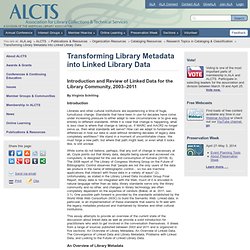
Standards that have been in use for decades have come under increasing pressure to either adapt to new circumstances or to give way entirely to different standards. While it is clear that change is happening, what is less clear is where that change is taking us. If MARC and AACR2 no longer serve us, then what standards will serve? While some do not believe, perhaps, that any sort of change is necessary at all, Coyle points out that library data, despite being saved and accessed via computers, is designed for the use and consumption of humans (2010b, 6). This essay attempts to provide an overview of the current state of the discussion about linked data as well as provide a solid introduction for practitioners who wish to get involved in the conversation themselves. What Could ITS 2.0 Offer the Web Manager? Back in October 2013 the W3C announced that the Internationalization Tag Set (ITS) version 2.0 had become a W3C recommendation.
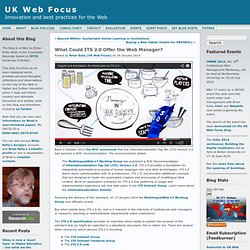
The announcement stated: The MultilingualWeb-LT Working Group has published a W3C Recommendation of Internationalization Tag Set (ITS) Version 2.0. ITS 2.0 provides a foundation for integrating automated processing of human language into core Web technologies. ITS 2.0 bears many commonalities with its predecessor, ITS 1.0, but provides additional concepts that are designed to foster the automated creation and processing of multilingual Web content. Work on application scenarios for ITS 2.0 and gathering of usage and implementation experience will now take place in the ITS Interest Group. Following the delivery of this standard, on 17 January 2014 the MultilingualWeb-LT Working Group was officially closed. But the resource I thought was particularly interesting was the ITS 2.0 video channel. Internationalization Tag Set Interest Group.
Asset Description Metadata Schema (ADMS) W3C Working Group Note 01 August 2013 This version: Latest published version: Previous version: Editors: Phil Archer , W3C / ERCIM Gofran Shukair , DERI, NUIG Author: Makx Dekkers , AMI Consult (original document) The vocabulary defined in this document is also available in these non-normative formats: RDF/XML and Turtle.
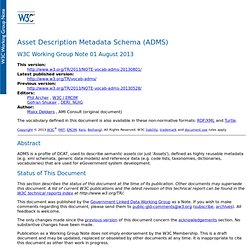
Copyright © 2013 W3C® (MIT, ERCIM, Keio, Beihang), All Rights Reserved. Abstract. Home - schema.org. Vocabularies at W3C. In my opening post on this blog I hinted that another would follow concerning vocabularies.
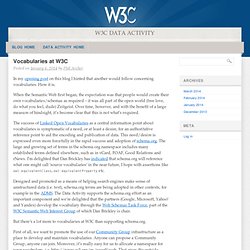
Here it is. When the Semantic Web first began, the expectation was that people would create their own vocabularies/schemas as required – it was all part of the open world (free love, do what you feel, dude) Zeitgeist. Over time, however, and with the benefit of a large measure of hindsight, it’s become clear that this is not what’s required. The success of Linked Open Vocabularies as a central information point about vocabularies is symptomatic of a need, or at least a desire, for an authoritative reference point to aid the encoding and publication of data.
Optimizing YouTube Metadata: Titles, Descriptions & Tags. YouTube is the world’s second largest search engine trailing behind only Google itself.
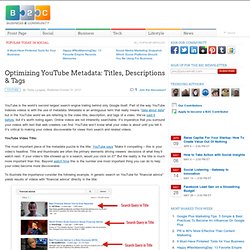
Part of the way YouTube indexes videos is with the use of metadata. Metadata is an ambiguous term that really means “data about data” but in the YouTube world we are referring to the video title, description, and tags of a video. We’ve said it before, but it’s worth noting again. Online videos are not inherently searchable. It’s imperative that you surround your videos with text that web crawlers can find. YouTube Video Title: The most important piece of the metadata puzzle is the title. To illustrate the importance consider the following example. Do a few other searches on YouTube and you’ll get similar results, so put your self in the shoes of one of your potential viewers. Growing Institutional Support for Data Citation: Results of a Partnership Between Griffith University and the Australian National Data Service. D-Lib Magazine November/December 2013 Volume 19, Number 11/12Table of Contents Growing Institutional Support for Data Citation Results of a Partnership Between Griffith University and the Australian National Data Service Natasha Simons Griffith University, Brisbane, Australia n.simons@griffith.edu.au.

Finglive. RDF et OWL pour donner du sens au Web - JDNet Développeurs. Le Web Sémantique s'est enrichi en 2003 de deux "Recommandations" du W3C, concernant les spécifications Resource Description Framework (RDF) et Web Ontology Language (OWL).
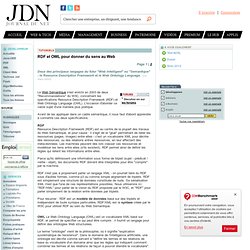
L'occasion d'aborder ce vaste sujet d'une manière plus pratique. Avant de les appliquer dans un cadre sémantique, il nous faut d'abord apprendre à connaître ces deux spécifications. RDF Resource Description Framework (RDF) est au centre de la plupart des travaux du Web Sémantique, et pour cause : il s'agit de la "glue" permettant de relier les ressources (pages, images ) entre elles - c'est un vocabulaire XML pour décrire des ressources, ou des relations entres ressources, en leur affectant des méta-données. Les machines peuvent dès lors classer ces ressources et modéliser les liens entre elles (s'ils existent). RDF permet ainsi de définir les règles qui relient les informations entre elles. Le terme "ontologie" vient de la philosophie, où il signifie "explication systématique de l'existence".